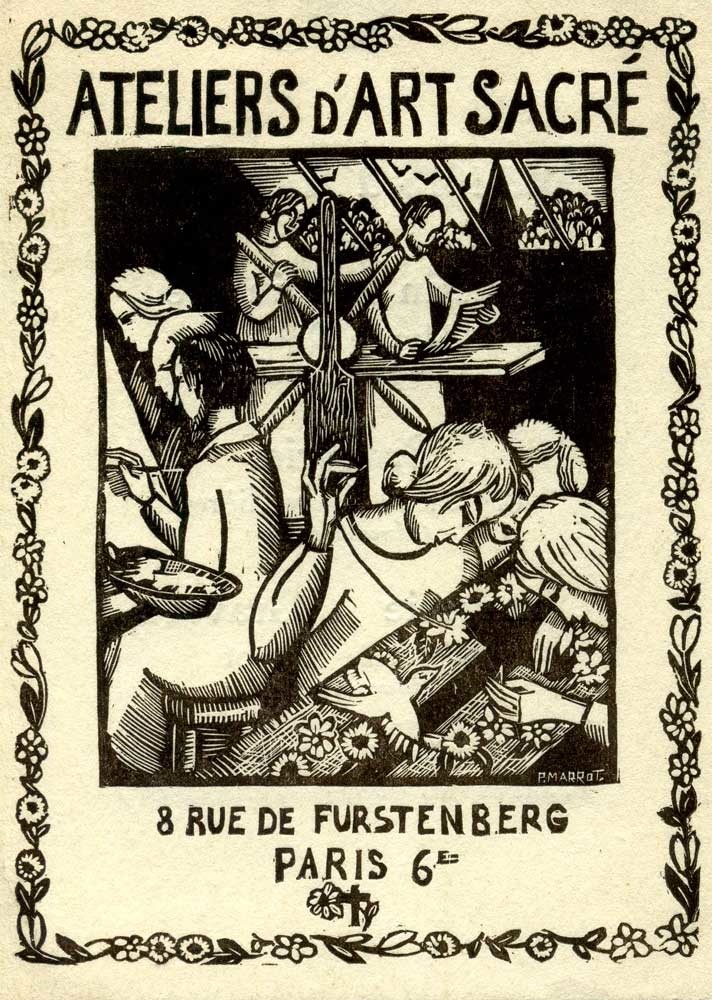PRINCIPLES OF THE ART
I have said how it is that we attempt to realise the religious part of this beautiful program. As concerns the purely artistic aspect, I maintain that there is no special formula for Christian art; as I have argued on a previous occasion, the symbolist point of view permits a sort of eclecticism, showing us lessons that can be learned from all schools and periods.
I exclude nothing except that which is not art - or that which contains no expression...
I proscribe academism because it sacrifices emotion to convention and to artifice, because it is either theatrical or insipid; but I will not be unjust toward the seventeenth century, nor to those works of the baroque era that express an intense, passionate interior life as in some of the great Spanish mystics. No more would I have the right to banish St. Francis de Sales or Bossuet from Catholic literature than to refuse to admire Bernini’s St. Theresa in Ecstasy or the noble chapel of the palace of Versailles.
I forbid Jansenism as being the death of art, coldness and ennui. That is what was responsible for the glacial, bourgeois style which spread everywhere in the nineteenth century, the timorous style which fears everything, fears becoming immoral, fears originality, fears life.
I forbid realism of the genre of Burnand and Tissot, as it is prose, and I want "music before all else ..." (12)
(12) Well-known quotation from Verlaine's Art Poétique.
As for the rest, all Catholic tradition - what am I saying? all humanity's religious traditions offer us models: Buddhist and Egyptian art, the metopes of Selinunte, (13) Zurbarán or Lesueur! But my preference is for the thirteenth century in France, a period of incomparable equilibrium between beauty of form and mystical expression; to the Italian primitives, while expressing certain reservations concerning Primitivism which, by dint of false naïveté and forced archaism, runs the risk of ending up as Dadaism.
(13) Bas-relief carvings from an ancient Greek city in Sicily.
Our great master will be Fra Angelico. Fra Angelico who was no reactionary, but an innovator, a man of his time and almost of all time [presqu'un classique]; and a saint …
And finally, I will preach Beauty. Beauty is an attribute of Divinity. The beauty of nature is a proof of God. The beauty of the human body gives the artist the idea of the perfect. Jesus Christ was beautiful; to imagine Him otherwise, to assimilate Him to St. Paul or to St. Francis, is to misapprehend His divinity. Yes, the Man of Sorrows, no matter however full of pain he might be, must be neither infirm nor degenerate. The Jansenists have denied the apologetic power of beauty long enough, repeating that the subjects of Christianity, the "terrible mysteries:"
D’ornements égayés ne sont point susceptible ... (14)
(14) "Are not at all susceptible to jolly decorations" - Well-known quotation from Boileau's L'Art poétique
The Jansenist spirit confuses frivolity with beauty, and the pleasure which a man of sense can derive from visiting a museum of antiquities must seem to him to be pleasure of a very low degree. Such severities are sterile and contrary to the whole of Catholic tradition. For too long the Michelets, the Lecontes de Lisle, the Renans, have denied the right to beauty, have attributed it to the votaries of pagan antiquity alone, decreeing that harmony and expression are antinomies, that there is war between the beauty of the body and that of the soul. How far can we go along that path? I answer, as far as Raphael, and let us seek no more perfect model than the Camera della Signatura.
Neither let us accede to the naughty pleasure to startle or to be obscure. If we must detest the errors of the public, let us still treat that public with love, as the sinner whose sin only we decry. The public to whom we dedicate our art is Christian, or, if it is not, it was still created and redeemed as we are. Let us be humble and charitable toward them. And in order to escape that sort of aesthetic Phariseeism, let us ask if we are not enjoying their scandalised attitude, when our Christian duty is, in all simplicity, to bring them up to our level, within the boundaries of Beauty….
Non nobis, Domine, non nobis, sed nomini tuo da gloriam ...
What will the future hold for a teaching of this sort and for the School of Sacred Art? It is up to the Catholics to say! It is up to them to show confidence in us and to help us in a difficult task, begun at least with conviction, with enthusiasm and, dare I say, with clarity of vision.
Whatever the future might hold, let us retain this consoling thought. We must flee from all forms of ugliness. Even as a believer has nothing to sacrifice in his knowledge of the demands of reason, the artist does not have to sacrifice beauty in Christian art. But it is plainly evident that what he must do before all else, is to draw us into his prayer. And he must seek his inspiration in the depths of his own self, in the intimate experience of his faith.
